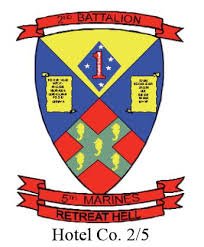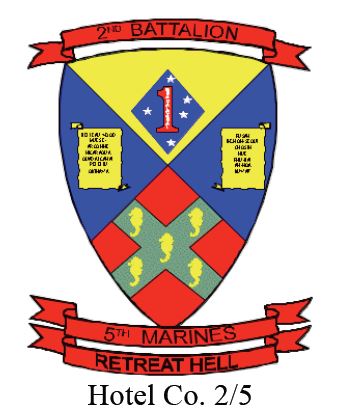The 1st Marine Division (1st MARDIV) is a Marine division of the United States Marine Corps headquartered at Marine Corps Base Camp Pendleton, California. It is the ground combat element of the I Marine Expeditionary Force (I MEF).
It is the oldest and largest active-duty division in the United States Marine Corps, representing a combat-ready force of more than 19,000 personnel. It is one of three active-duty divisions in the Marine Corps today and is a multi-role, expeditionary ground combat force. It is nicknamed “The Old Breed”. 
The division is employed as the ground combat element (GCE) of the I Marine Expeditionary Force or may provide task-organized forces for assault operations and such operations as may be directed. The 1st Marine Division must be able to provide the ground amphibious forcible entry capability to the naval expeditionary force (NEF) and to conduct subsequent land operations in any operational environment.
For those of us who served in Vietnam, we were a combat element of the newly formed (in Vietnam in 1965), III Marine Amphibious Force (III MAF), comprising of the 3rd Marine Division, the 1st Marine Aircraft Wing (MAW), and the 1st Marine Division. Since the Vietnam Era, III MAF was redesignated to III Marine Expeditionary Force (III MEF), 5 February 1988, and is forward-deployed and headquartered in Okinawa, Japan (2023). The 1st Marine Division, however, no longer a part of III MEF, became part of I MEF and is located and headquartered in Camp Pendleton, California. Hotel 2/5 served in the 1st Marine Division during the Vietnam War. Hotel Company no longer exists in the Marine Corps after its downsizing and restructuring of combat troops after the Vietnam War.
Click here to see the 1st Marine Division Website of today.
In The Vietnam War
The USMC 1st Marine Division lost 7,012 men killed in action (KIA) in South Vietnam.
3/3 Marines observe an airstrike during Operation Harvest Moon
1965
In August 1965, the division’s 7th Marine Regiment participated in three operations against the Vietcong (VC) for American ground troops in South Vietnam. On 22 February 1965, General William C. Westmoreland, USA, Commander, US Military Assistance Command, Vietnam, requested two Marine battalions to protect the key airbase at Da Nang from increasing threat by the Viet Cong to U.S. installations. In response, on 8 March 1965, the 9th Marine Expeditionary Brigade (MEB) landed at Da Nang.
By the end of March, nearly 5,000 Marines were at Da Nang, including two infantry battalions, two helicopter squadrons, and supply and logistics units. In April the U.S. Government agreed to deploy still more Marines to Vietnam and to permit those at Da Nang to engage in counterinsurgency operations. In June, Major General Lewis W. Walt arrived to take command of the newly formed III Marine Amphibious Force (MAF), comprising both the 3d Marine Division and the 1st Marine Aircraft Wing (MAW).
By mid-summer, the Marines had moved outside their cantonment at Da Nang and expanded their Area of Responsibility (AOR) to include the Viet Cong-infested villages to the south. Marines landed at Chu Lai, allowing the 1st Wing to expand to new facilities there and at Marble Mountain, home of Marine Aircraft Group (MAG) 36, while MAG-16 remained at the airbase at Da Nang.
In August, Marines engaged in their first major offensives against the Viet Cong, Operation Starlite, which included the 7th Marines, the vanguard of the 1st Marine Division. The action destroyed one Viet Cong battalion and badly mauled a second. By the end of the year, Gen Walt commanded 42,000 Marines. Despite operational successes, pacification in the densely populated areas in the Marine’s AOR remained a difficult process. With no end to the war in sight, the prediction of a Vietnamese soothsayer would come true: 1966 would be a year of a “lot of fighting and killing.”
1966
In March 1966 division elements conducted operations Utah, Oregon, and Texas. March also saw the 1st Marine Division Headquarters established at Chu Lai. By June, the entire division was in South Vietnam, and its Tactical Area of Responsibility (TAOR) was the southern two provinces of I Corps — Quang Tin and Quang Ngai. In August the division conducted Operation Colorado. Between March and October 1966 to May 1967, the division conducted 44 named operations. The division received its 7th Presidential Unit Citation for service from 29 March 1966 to 15 September 1967.
1967
From January to April 1967 the 7th Marines conducted Operation Desoto. In early April 1967 under Operation Oregon the division moved north to Da Nang to support the 3rd Marine Division and Task Force Oregon took over the division’s former TAOR. From April through November, Division units conducted many operations conducting operations with the Army of the Republic of Vietnam (ARVN) forces. On 4 December 1967 Task Force X-Ray was activated to implement Operation Checkers, the movement of the 1st Marine Division from Thừa Thiên Province north to Quảng Trị Province to support the 3rd Marine Division which was engaged in heavy combat along the Vietnamese Demilitarized Zone. From 28 December 1967 to 3 January 1968 Division units conducted Operation Auburn on Go Noi Island south of Da Nang.
1968
On 11 January 1968 Task Force X-Ray headquarters was established at Phu Bai Combat Base and assumed operational control of the 5th Marine Regiment which moved north from Da Nang and the 1st Marine Regiment already based at Phu Bai. When the 1968 Tet Offensive began at the end of January, the division was involved in fierce fighting with PAVN/VC throughout its TAOR and together with ARVN units would defend Da Nang and fight the Battle of Huế. The 1st Marines would receive a Presidential Unit Citation for its actions at Huế. From May to August Division units conducted Operation Allen Brook on Go Noi Island. From May to October Division units conducted Operation Mameluke Thrust in Happy Valley southwest of Da Nang. From 1 to 19 October Division units conducted Operation Maui Peak to relieve Thường Ðức Camp. From late October to early December the 5th Marines conducted Operation Henderson Hill in Happy Valley. From 20 November to 9 December Division units conducted Operation Meade River south of Da Nang.
1969
From 6 December to 8 March 1969 Division units conducted Operation Taylor Common in the An Hoa Basin west of Hội An. From 31 March to 29 May 1969 Division and ARVN units conducted Operation Oklahoma Hills southwest of Da Nang. From 26 May to 7 November Division, ARVN and Republic of Korea Marine Corps (ROKMC) units conducted Operation Pipestone Canyon on Go Noi Island.
On 7 June PFC Dan Bullock of 2/5 Marines was killed in a PAVN sapper attack on An Hoa Combat Base, having lied about his age to enlist, he was, at 15 years old, the youngest American killed in the war.
1970
From July to August 1970 Division units conducted Operation Pickens Forest southwest of An Hoa Combat Base. From 1 September to 7 May 1971 Division and ROKMC units conducted Operation Imperial Lake in the Quế Sơn District south of Da Nang.
1971
On 13 January 1971 Operation Keystone Robin Charlie began with the standing down of the initial units supporting the division. The redeployment accelerated in mid-February but then slowed when HMH-463, HML-167, HMM-263 and MASS-3 were retained to support Operation Lam Son 719. Throughout April the remaining Division units transferred bases and tactical areas of responsibility to the Americal Division. On 14 April 1971 the 3rd Marine Amphibious Brigade was activated at Camp Jay K. Brooks and III Marine Amphibious Force transferred all remaining Marine forces to it. On 30 April President Richard Nixon welcomed the division back to Camp Pendleton and awarded it a second Presidential Unit Citation for its service in South Vietnam.
1975
In 1975, the division supported the resettlement of South Vietnamese refugees by providing food and temporary shelter at Camp Pendleton for Vietnamese refugees as they arrived in the United States.


